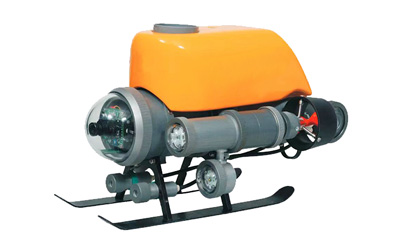The front dome of the deep-sea robot is designed to resist pressure and corrosion, protecting internal equipment and ensuring stable operation in extreme environments.
The dome is used to safeguard the front end of the robot to facilitate its operation in extreme underwater circumstances. The front dome of the deep-sea robot is engineered to confront the pressure and corrosiveness of the deep-sea environment.
Owing to the extreme pressure of the deep-sea setting and the highly corrosive nature of seawater, the front section of the robot demands special protection. The dome configuration can effectively withstand the high pressure of the deep sea, concurrently prevent the ingress of seawater and corrosive substances, and safeguard the mechanical and electronic apparatuses inside the robot from damage. This design enables the deep-sea robot to operate stably in the extreme underwater environment, to undertake scientific research, exploration, mining, and other tasks.
Additionally, the dome design also takes into account the particular challenges of the deep-sea environment, such as the thermal expansion and contraction of materials resulting from temperature variations, and the impact of seawater corrosion and deep-sea pressure on the robot. By employing special materials and reinforcing methods, it ensures the "structural seal" of the robot in an extremely cold environment, thereby ensuring the stability and reliability of the robot in a complex environment.
For the dome used in deep-sea imaging and ROV, in addition to requiring high-precision surface accuracy, it must also withstand a certain water pressure.
The BENA Optics team, while continuously improving the surface accuracy of optical dome, improves the customer's design, selects materials accurately, and enhances the surface strength through physical annealing. At present, the Bena optics' dome can reach the deepest depth of 3000m as the leading optical components company in China.

| Structure | Hemisphere/hyper-hemisphere |
| Material | Fused silica/Borosilicate |
| Diameter | Ø60mm-Ø230mm |
| Diameter tolerance | ±0.1mm |
| Thickness tolerance | +0.0mm/-0.1mm |
| Surface quality | 20/10 |
| Surface accuracy | 10 (3) |
| Coating | AR Coating and waterproof coating |
| Strengthened via heat treatment (tempering) | |
| Type No. | Out diameter | Height | Wall thickness |
| (mm) | (mm) | (mm) | |
| DW-60 | 60 | 30 | 5 |
| DW-70-A | 70 | 35 | 5 |
| DW-70-B | 70 | 35 | 8 |
| DW-75 | 75 | 37.5 | 3 |
| DW-76 | 76 | 38 | 6 |
| DW-80 | 80 | 40 | 4 |
| DW-100-A | 100 | 50 | 2 |
| DW-100-B | 100 | 50 | 4 |
| DW-100-C | 100 | 50 | 5 |
| DW-127 | 127 | 50.8 | 4 |
| DW-136 | 136 | 60 | 4 |
| DW-140-A | 140 | 70 | 4 |
| DW-140-B | 140 | 70 | 12 |
| DW-170 | 170 | 56 | 6.5 |
| DW-180 | 180 | 60 | 7.5 |
| DW-184 | 184 | 61 | 7 |
| DW-190 | 190 | 95 | 5 |
| DW-203 | 203 | 80 | 4 |
| DW-212 | 212 | 106 | 6 |
| DW-230 | 229.6 | 87.4 | 8 |
The application of optical dome lens in ROV is mainly reflected in its function of protecting and enhancing optical equipment . Need to meet the requirements of fluid mechanics. Its optical axis is strictly concentric with the mechanical axis to ensure that the Gaussian index and optical resolution of the rear optical objective are not affected.
Protective optical equipment: The optical ball cover can protect the camera, laser and other optical equipment installed on the submarine robot from seawater corrosion and physical damage, thus extending the service life of the equipment.
Enhanced optical performance: By reducing the scattering and absorption of light by seawater, the optical ball cover can improve the transmittance and image quality of the optical equipment, enabling the robot to capture images and videos of the seabed more clearly.
Adapt to complex environment: Due to the complexity and variability of the seabed environment, the design of the optical ball cover needs to take into account the hydrodynamics and pressure resistance performance to ensure stable operation in high-speed movement and deep water environment.
